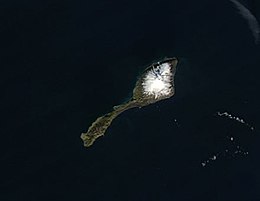This article needs additional citations for verification. (May 2020) |
 NASA satellite image of Jan Mayen, Beerenberg covered with snow | |
 | |
| Geography | |
|---|---|
| Location | Arctic Ocean |
| Coordinates | 70°59′N 8°32′W / 70.983°N 8.533°W |
| Area | 377 km2 (146 sq mi) |
| Coastline | 124,100 m (407200 ft) |
| Highest elevation | 2,277 m (7470 ft) |
| Highest point | Beerenberg |
| Administration | |
| Unincorporated area | Jan Mayen |
| Largest settlement | Olonkinbyen (pop. 35) |
| Demographics | |
| Population | 0 (up to 35 non-permanent residents) |
| Additional information | |
| Time zone | |
| Postal code | 8099 |
| ISO 3166 code | SJ |
Jan Mayen (Urban East Norwegian: [jɑn ˈmɑ̀ɪən])[1] is a Norwegian volcanic island in the Arctic Ocean with no permanent population. It is 55 km (34 mi) long (southwest-northeast) and 373 km2 (144 sq mi) in area, partly covered by glaciers (an area of 114.2 km2 (44.1 sq mi) around the Beerenberg volcano). It has two parts: larger northeast Nord-Jan and smaller Sør-Jan, linked by a 2.5 km (1.6 mi) wide isthmus. It lies 600 km (370 mi) northeast of Iceland (495 km [305 mi] NE of Kolbeinsey), 500 km (310 mi) east of central Greenland, and 900 km (560 mi) northwest of Vesterålen, Norway.
The island is mountainous, the highest summit being the Beerenberg volcano in the north. The isthmus is the location of the two largest lakes of the island, Sørlaguna (South Lagoon) and Nordlaguna (North Lagoon). A third lake is called Ullerenglaguna (Ullereng Lagoon). Jan Mayen was formed by the Jan Mayen hotspot and is defined by geologists as a microcontinent.[2]
Although administered separately, in the ISO 3166-1 standard, Jan Mayen and Svalbard are collectively designated as Svalbard and Jan Mayen, with the two-letter country code "SJ". It was also given the web domain of .sj. However, the domain is not in use and Norway's .no is used in its place.
Jan Mayen is home to Beerenberg, which is the northernmost subaerial active volcano in the world.[3][4]
- ^ Berulfsen, Bjarne (1969). Norsk Uttaleordbok (in Norwegian). Oslo: H. Aschehoug & Co (W Nygaard). p. 157.
- ^ "Jan Mayen er et bitte lite kontinent". September 2022. Archived from the original on 9 October 2022. Retrieved 9 October 2022.
- ^ Quinn, Joyce A. (2015). Earth's Landscape: An Encyclopedia of the World's Geographic Features. ABC-CLIO. Page 362. ISBN 9781610694469.
- ^ Central Intelligence Agency (2016). The World Factbook 2009. U.S. Executive Office of the President. Page 323. ISBN 9781597974141.